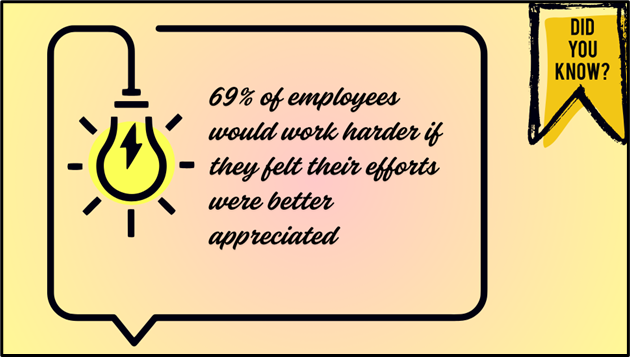
02 Jun How HR Can Leverage Recognition To Boost Workplace Performance
In today’s talent-driven economy, human resources leaders face increasing pressure to retain top talent, improve engagement, and foster high-performing teams. One proven, yet often underutilized, HR strategy is employee recognition. While 82% of American professionals report feeling underappreciated at work, structured recognition programs can significantly boost morale, reduce turnover, and reinforce company values, without large financial investment.
Employee recognition isn’t just about handing out praise, it’s about creating a culture where effort and impact are truly valued. In this post, we’ll break down the real benefits of employee recognition and how to make your efforts truly meaningful.
Core Benefits of Recognition Systems
Implementing the best employee recognition software can transform your workplace culture while delivering measurable results across multiple areas of your business.
Boosting Employee Engagement
Recognition directly impacts employee engagement levels. When people feel their contributions matter, they become more emotionally invested in their work and your company’s success. When HR integrates recognition into day-to-day management, it strengthens employees’ connection to their roles, leading to greater discretionary effort—going beyond the job description to add value.
Improving Retention and Loyalty
Employees who feel valued stick around longer. Regular recognition creates stronger bonds between team members and your organization, making it harder for competitors to lure away your top talent. This loyalty translates to institutional knowledge retention and consistent performance over time.
Fostering Innovation and Creativity
When employees know their ideas are welcomed and appreciated, they’re more willing to offer creative solutions and think outside the box. Recognition creates psychological safety—the feeling that taking risks won’t result in punishment or embarrassment—which is essential for innovation to flourish.
These benefits compound over time, creating a workplace where people are engaged, loyal, and constantly bringing fresh ideas to the table.
Psychological Foundations of Recognition
To maximize recognition’s impact, management must understand how the brain responds to appreciation and how that translates to workplace behavior.
How Our Brain Processes Appreciation
When we notice what someone has done well, their brain produces dopamine and reminds them of positive feelings related to their job. Thanks to this reaction in the brain, employees are likely to reproduce actions for which they received praise. This response in our bodies clarifies why employee recognition gives more than a mood boost.
Fulfilling Basic Human Needs
Being recognized gives humans what they need in the way of belonging, esteem and personal fulfillment. Feeling competent and appreciated is important to people to achieve success, say motivation theories. Giving acknowledgment often helps satisfy employees’ psychological needs, so they are satisfied and motivated.
Different Languages of Appreciation
Just as people have different love languages in personal relationships, they also respond differently to various forms of workplace appreciation. Some prefer public recognition, others value tangible rewards, while some appreciate one-on-one acknowledgment.
Understanding these preferences helps you tailor your approach for maximum impact.
Armed with these psychological insights, you can create recognition experiences that truly resonate with your team members on a deeper level.
The Business Case for Recognition Programs
It’s important to understand the concrete business benefits that make these programs worth your investment.
Lower Employee Departure and Lower Financial Cost
Companies using planned employee attention programs see a decrease in employee turnover. If employees feel appreciated, they’ll be more likely to stay, which can save your business from spending valuable capital on hiring someone new. It’s simple: investing in good employees costs less than looking for and training new ones.
Better Results and Performance
Being appreciated at work leads to better performance. Feeling appreciated for their work encourages people to do more than their daily responsibilities. Being noticed for certain behaviors helps others repeat them, which ensures your organization performs well consistently.

Strengthened Company Culture
A good recognition program helps to demonstrate your company’s core principles each time recognitions are given. If you notice and welcome actions that reflect your key beliefs, you show what your organization values, and everyone starts moving in the same direction.
Encoding recognition in your culture leads to outcomes that impact your business in every way and your bottom line.
Effective Recognition Delivery Methods
How you deliver recognition can be just as important as the recognition itself. Finding the right mix of approaches ensures your efforts have maximum impact.
Digital vs. In-Person Recognition
Although coming across someone personally can be warm, digital solutions allow you to reach more and work with greater ease. Distributed or remote groups are often immediately acknowledged by organizations using ecards and online recognition tools. A great strategy typically adds digital methods to traditional face-to-face approaches for a better outcome.
Monetary vs. Non-Monetary Approaches
Money can help motivate people, but research tells us that non-financial rewards inspire people to last longer. Sometimes, appreciation gifts, notes, or public acknowledgment are more meaningful to an employee than a bonus that is soon spent and soon forgotten.
Peer-to-Peer vs. Manager-Led Recognition
Most often, management recognizes people, but peer-to-peer programs allow everyone in the workplace to show appreciation. Such programs find hidden achievements of team members, increase team spirit, and make the working environment more welcoming to everyone.
Finding the right mix of these approaches ensures your recognition efforts reach everyone in ways that feel meaningful and authentic.
Building a Recognition-Rich Culture
Creating a sustainable culture of recognition requires intentional effort and consistent reinforcement throughout your organization.
Training Managers as Recognition Champions
Managers set the tone for recognition within their teams. Providing training on the importance of recognition, effective delivery methods, and overcoming recognition resistance helps ensure consistent implementation across your organization.
When leaders model recognition behaviors, they normalize appreciation throughout the company.
Measuring Recognition Program Impact
What gets measured gets managed. Tracking recognition activities, employee engagement scores, and business outcomes helps you demonstrate program ROI while identifying opportunities for improvement.
Many ways to recognize employees that can be measured and refined based on the data you collect.
By focusing on these cultural elements, recognition becomes woven into the fabric of your organization rather than feeling like an occasional add-on program.
Utilizing Recognition for Benefit at Your Organization
Employee recognition remains one of the most cost-effective strategies HR leaders can use to boost performance, strengthen culture, and retain top talent. When implemented consistently and thoughtfully, recognition not only affirms employees’ value, it also reinforces core organizational values, supports long-term engagement, and cultivates a more resilient, aligned workforce.
For professionals focused on sustainable growth and talent retention, strategic recognition isn’t just a best practice, it’s a business imperative.
FAQs
1. What can employers do to recognize their team without spending money?
Personal notes of thanks, praising employees openly, letting them set their own schedule, supporting their continued growth, and having them participate in major meetings require no payment but say a lot.
2. When should employees get recognized by their managers?
When someone deserves it, recognition should happen, but marking at least one week with positive recognition helps your team feel like they are truly valued. Certain organizations determine how often gratitude should be shared, but also let employees say thanks whenever the mood hits for the best results.
3. How can small businesses set up effective recognition efforts?
Limited resources allow small organizations to value their team by offering personal acknowledgment, flexible rewards, marking important achievements, and reacting flexibly to successes.
About The Author
Daniel Martin loves building winning content teams. Over the past few years, he has built high-performance teams that have produced engaging content enjoyed by millions of users. After working in the Aviation industry for ten years, today, Dani applies his international team-building experience at organiclinkbuilders.com to solving his client’s problems. Dani also enjoys photography and playing the carrom board.
No Comments